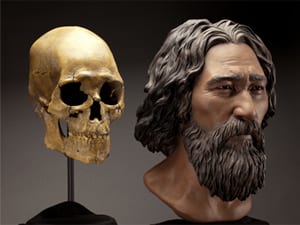
Alaska news reporter Mike Dunham with the Alaska Dispatch News covered the research of SMU paleontologist Louis L. Jacobs, a professor in the Roy M. Huffington Department of Earth Sciences, Dedman College of Humanities and Sciences, and paleontologist Anthony Fiorillo, vice president of research and collections and chief curator at the Perot Museum of Nature and Science, Dallas, and an adjunct research professor at SMU.
Jacobs and Fiorillo are co-authors of a study about the identification of new fossils from the oddball creature Desmostylia, discovered in the same waters where the popular “Deadliest Catch” TV show is filmed. The hippo-like creature ate like a vacuum cleaner and is a new genus and species of the only order of marine mammals ever to go extinct — surviving a mere 23 million years.
Desmostylians, every single species combined, lived in an interval between 33 million and 10 million years ago. Its strange columnar teeth and odd style of eating don’t occur in any other animal, Jacobs said. The new specimens — from at least four individuals — were recovered from Unalaska, an Aleutian island in the North Pacific.
The authors reported their discovery in a special volume of the international paleobiology journal, Historical Biology. The article published online Oct.1 at http://bit.ly/1PQAHZJ.
The article published Oct. 7, 2015.
EXCERPT:
By Mike Dunham
Alaska Dispatch News
It had the face of a walrus, swam like a polar bear, was as big as a hippopotamus and sucked its food off the rocks and mud around the Aleutian Islands 23 million years ago. “Ounalashkastylus tomidai” was described by a team of paleontologists from Texas, Canada and Japan in an article published in the scientific journal Historical Biology on Oct. 1.Louis L. Jacobs, a vertebrate paleontologist at Southern Methodist University in Dallas and co-author of the study, said in a press release the extinct marine mammal was a vegetarian with a long snout and tusks. It grazed on plants growing along the shoreline, rooting them out then sucking them in like a vacuum cleaner. It was a style of eating not found in any other animal.
The new species, a member of the order Desmostylia (des-mo-STILL-ee-uh), was identified from four specimens found on Unalaska over a period of years beginning in 1950, when fossils were discovered in a quarry. More emerged during excavations for the foundation of Eagle View Elementary School, said Alaska artist Ray Troll, an avid follower of paleontology and illustrator of extinct animals.
Anthony Fiorillo of the Perot Museum of Nature and Science in Dallas, another co-author of the study, told Alaska Dispatch News the find involved a good deal of serendipity. Fiorillo, who has made several important paleontological discoveries in Alaska, had planned to work in the Yukon-Charlie area in 2004, but wildfires and smoke made that impossible.
“I looked at the weather map, and the only place I could find that wasn’t affected was Unalaska,” he said. So he switched his destination. While there he gave a talk at the Museum of the Aleutians, where he learned about the fossils. They were being kept at the headquarters of the local Native corporation. “The Unalaska museum facilitated the loan of the fossils to the Perot Museum where we could study them. Louis Jacobs was with me, so it made sense for us to work on it together.”
Follow SMUResearch.com on twitter at @smuresearch.
SMU is a nationally ranked private university in Dallas founded 100 years ago. Today, SMU enrolls nearly 11,000 students who benefit from the academic opportunities and international reach of seven degree-granting schools. For more information see www.smu.edu.
SMU has an uplink facility located on campus for live TV, radio, or online interviews. To speak with an SMU expert or book an SMU guest in the studio, call SMU News & Communications at 214-768-7650.


 $3.78 million awarded by Department of Defense to SMU STEM project for minority students
$3.78 million awarded by Department of Defense to SMU STEM project for minority students Kennewick Man: genome sequence of 8,500-year-old skeleton solves scientific controversy
Kennewick Man: genome sequence of 8,500-year-old skeleton solves scientific controversy At peak fertility, women who desire to maintain body attractiveness report they eat less
At peak fertility, women who desire to maintain body attractiveness report they eat less